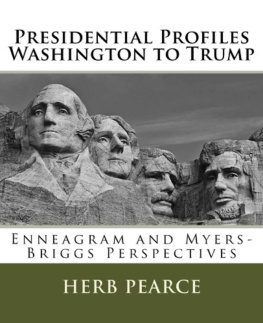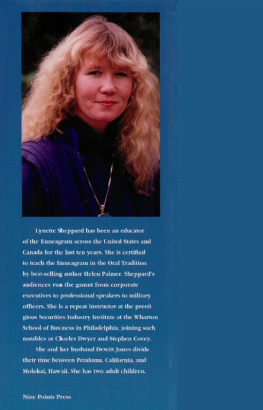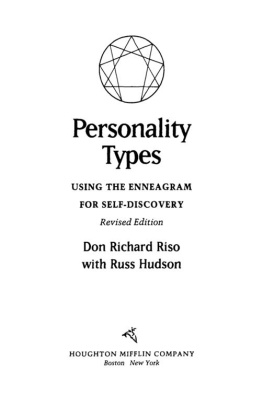Presidential Profiles
Washington to Trump
Enneagram and Myers-Briggs Perspectives
by Herb Pearce
Acknowledgements:
I would like to acknowledge my chief editor Jan Larivee for an amazing job. Many other people helped edit chapters in the initial stage: Connie Farley, Sherry Greene, Felice Katz of Graphics to Go, Steven Orzack, Sue Johnson, Helene Martel, William Buonopane, Ariane Cherbuliez, Stephen Wingate, Cathy Reuben, David Anick, Linda Glazer, Emily Page, Rick Charnes, Reed Synder, John OLeary and Cliff Putney. Many others helped in encouragement, title suggestions and emotional support. Thank you so much for your contributions.
Photo on front cover, author: Cuvafitness /commons.wikimedia.org/wiki/File:Mount_Rushmore_"The_Presidents".jpg, Mount Rushmore, South Dakota
INTRODUCTION
This book explores the personalities of all United States Presidents, with the addition of understanding their Enneagram and Myers-Briggs personality types. Its a challenge to discover the real personality of each president due to the abundance of myth and image-making that surrounds the office in general. This includes exaggerated anecdotes and stories, debunking from opposed political parties, inaccurate or contradictory information, patriotic rewriting of history and skewed perspectives. Ive read many articles and books, quotes from people who knew them, diary entries, historical analyses and watched documentaries about the presidents. I have gathered and studied in depth a great deal of presidential information. All this research has been combined with my own experience with the Enneagram and Myers-Briggs. In this work I have attempted to reflect the basic personality structure of each president with strengths and weaknesses, complexities and contradictions.
Many presidents came from moneyed or prestigious backgrounds, though some were middle class and some were from poor backgrounds. Eleven of the presidents were generals, though most were politicians by trade. Many were lawyers though some were merchants, educators or businessmen. I have concentrated on providing descriptions, incidents, stories, and quotes from the presidents themselves or political commentators that reflect a relatively consistent personality makeup of each president during his lifetime. The focus is on the entire life of each president before, during and after his presidency.
Pressure to be ambitious, family background and marital partner, historical trends of the time, and regions of the country also reflect upon the Type that I have chosen and will comment on.
There are 44 Presidents including Donald Trump, as Grover Cleveland, president number 22 and 24, had two non-consecutive terms; that is, he won, then lost, then won again. Its traditionally been labeled as 45 presidents (Cleveland counted twice) and in the book, I do that, president number 1, president 2, president 3, etc. through 45.
My type conclusions come from a number of sources books and articles, The History Channel Presidential TV documentaries, National Geographic and other TV network specials or miniseries that I read articles about for historical accuracy, hundreds of articles and book reviews online, history lectures and author book reviews downloaded to YouTube, talking to historians, studying many paintings and photographs, attending lectures about presidents at the Massachusetts Historical Society in Boston, visiting presidential sites such as the Adams Estate and an eight-day visit to presidential mansions in Virginia, and thousands of hours of reading related to American history, my minor in history in college and my 28-year-plus experience teaching the Enneagram and Myers-Briggs. My four years in the US Navy contributed to my understanding of how military history fits into the presidency. I was a sailor on the USS Intrepid aircraft carrier which is now a museum in New York City. I was among the first race relations teachers in the Navy.
I typed every president independently, based on my research and years of typing people, before I looked at how others have typed the presidents. Ive been an avid student of American history since elementary school.
I think our presidents reflect American culture and peoples process of growth, as well as the many factions in American society at any point in its history. The struggles between those factions represent the struggles between rich and poor, big business and small enterprise, independence and interdependence, trust and fear, regional, cultural and racial divides and degrees of maturity and immaturity. History swings back and forth from the tried and true to experimentation, between what has worked in the past with what modern life and change bring to bear.
A focus of the book will be on Enneagram type dynamics, as well as the Myers-Briggs type, which I decided to add after I had typed each president in the Enneagram. The research into the Myers-Briggs types helped me change some of the Enneagram types of the president. I consider myself more a specialist on the Enneagram, though I have taught the Myers-Briggs for over 20 years.
This is also a basic history, though not a comprehensive one of the presidents and certainly not a major history book of historical documentation. Each presidents presentation is a summary of some political facts and biography, and just as important, personality. I try to give stories and evidence that reflect the types. Each chapter is unique, with no regular structure presented for each president.
There is often debate and disagreement by the experts on the details and interpretations about each presidents motivations and behavior. I try to pick out relevant features that many historians will agree on, and find a balance between the personality strengths and limitations of each president.
Presidents are ranked very differently by historians based on what criteria they consider important. Washington, Lincoln and Franklin Roosevelt, for instance, are usually ranked highly, though some historians or ranking systems rate those presidents at the bottom of the list. Presidents in office during times of war are often ranked higher than peacetime presidents. Presidents can be rated on the economy or prosperity, foreign relations, relationship to Congress, record of promoting peace, conservatism, conservation of land, promotion of business and corporations, minority rights, equal rights record for more modern presidents, public opinion, legislative record, honesty, toughness, power, relationship to the military or other categories.
I make comments on subtypes at times, type aspects other than the dominant type such as secondary type (type used secondarily and often mistaken as the core type), wings and also maturity levels. Articles at the end of the book explain types, subtypes and wings more thoroughly. I make personal comments at times on the presidents, their wives and their influence, their legacies and the historical policies of the United States government.
By all means, feel free to disagree with my analyses. Each typing is based on many hours of research and thought. There were occasional shocks to my system of what I had previously thought or had been taught about some of the presidents. I do believe if I missed the core type of a president, my type analysis is likely the secondary type or certainly an important type feature of that president. Several of the presidents Ive been in debate about regarding type for years, and I make comments on that and the process I went through in typing. Feel free to communicate with me regarding type and your opinions.
The purpose of the book is to give a human understanding of how each president saw the world in general and also how he responded to it from the perspective of his Enneagram and Myers-Briggs makeup. This process was also a way for me, and hopefully you, to understand the Presidents and American history a little more in depth. I make more comments from the Enneagram perspective than the Myers-Briggs, though the two systems often are intimately related.
Next page







